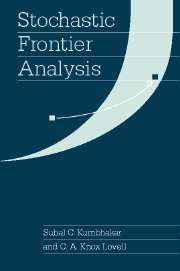Book contents
- Frontmatter
- Contents
- Preface
- 1 Introduction
- 2 Analytical Foundations
- 3 The Estimation of Technical Efficiency
- 4 The Estimation and Decomposition of Cost Efficiency
- 5 The Estimation and Decomposition of Profit Efficiency
- 6 The Shadow Price Approach to the Estimation and Decomposition of Economic Efficiency
- 7 Incorporating Exogenous Influences on Efficiency
- 8 The Estimation of Efficiency Change and Productivity Change
- References
- Author Index
- Subject Index
6 - The Shadow Price Approach to the Estimation and Decomposition of Economic Efficiency
Published online by Cambridge University Press: 05 June 2012
- Frontmatter
- Contents
- Preface
- 1 Introduction
- 2 Analytical Foundations
- 3 The Estimation of Technical Efficiency
- 4 The Estimation and Decomposition of Cost Efficiency
- 5 The Estimation and Decomposition of Profit Efficiency
- 6 The Shadow Price Approach to the Estimation and Decomposition of Economic Efficiency
- 7 Incorporating Exogenous Influences on Efficiency
- 8 The Estimation of Efficiency Change and Productivity Change
- References
- Author Index
- Subject Index
Summary
INTRODUCTION
In Chapter 3 technical inefficiency was modeled as an error component within a stochastic frontier framework. In Chapter 4 and parts of Chapter 5 cost inefficiency and profit inefficiency were also modeled as error components within a stochastic frontier framework. Thus the basic strategy in previous chapters has been to construct a composed error stochastic frontier model, and to extract estimates of inefficiency from the parameters describing the structure of the two error components. This procedure is straightforward in single-equation models, in whih the sole objective is to estimate technical or economic inefficiency. However this procedure is much less straightforward in simultaneous-equation models, in which the dual objectives are to estimate and decompose economic inefficiency.
In this chapter we change our strategy. We do not estimate stochastic frontiers. Instead, we model all types of inefficiency parametrically, through the introduction of additional parameters to be estimated, rather than through an error component. The error structure of the estimating equation (or system of equations) is conventional, the same as that employed in the estimation of cost, revenue, or profit functions in the nonfrontier literature. Thus the error term is distributed normally in a single-equation model, and the error terms are distributed as multivariate normal in a system of equations model.
Technical inefficiency is introduced in two alternative ways. Output-oriented technical inefficiency is introduced by allowing the production function intercept to vary across producers; this generates a cost function in which producers' output vectors are scaled differentially, and a profit function in which producers' output price vectors are scaled differentially.
- Type
- Chapter
- Information
- Stochastic Frontier Analysis , pp. 216 - 260Publisher: Cambridge University PressPrint publication year: 2000
- 1
- Cited by



